
“If you can not measure it, you can not improve it.” – Lord Kelvin
There is a precept that what you can measure, you can improve. And with the abundance of tracking technology available to us today, it can be easy to be overwhelmed by the number of things you have to keep track of.
As a reader of Asian Efficiency, you’re likely already managing your schedule, your tasks, your email and your information, so the last thing we want you to do is to have to track a bunch of different life metrics.
There is only one metric that truly matters when it comes to productivity: your time.
Time is the only metric that matters
Time is the one resource that everyone has the same amount of (unless you factor in outsourcing and delegation). And so, how you decide to and how you actually spend it is of vital importance and should be of significant interest to you. As Roger Hamilton says in the parable Wink, you get 24 drops of time each day. Do you want to waste, spend, drink or invest them?
Especially for those AE readers who work from home, or who don’t have the structure of a 9-5 work environment, how you spend every single minute of every day is incredibly important.
Enter Toggl
Toggl is an application that was introduced to me by a friend of mine, who used it for measuring billable hours and project work. I’ve since repurposed it for a more personal use.
The setup and application is incredibly simple. You open an account:
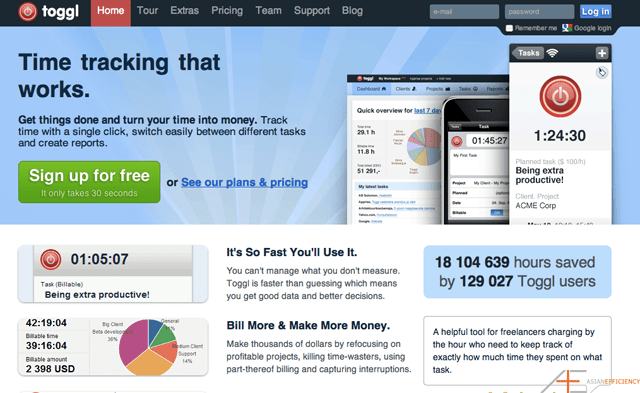
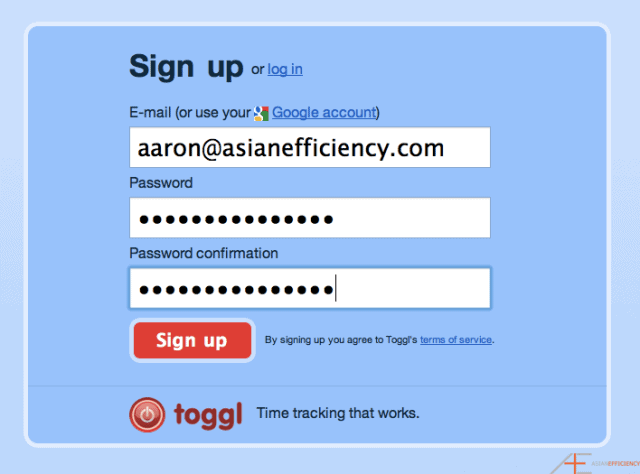
You then set up your projects (we’ll go through exactly what projects you need in detail below):
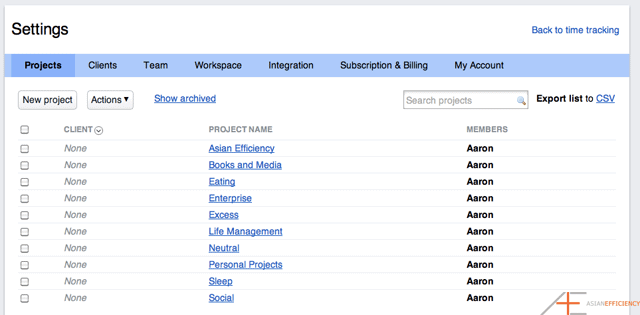
You download the mobile application:
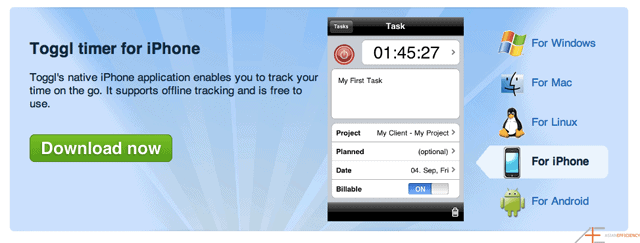
And then you start using it:
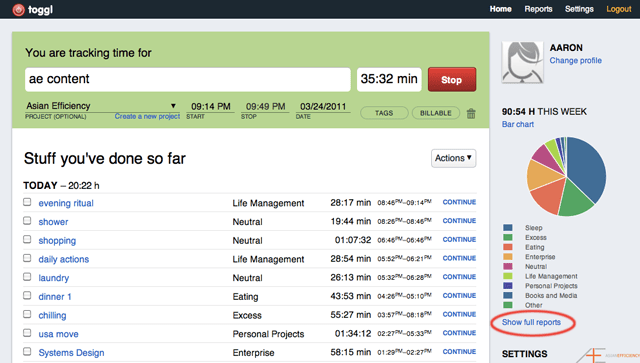
Toggl has applications for iOS and the Android platform, as well as desktop (I would avoid their desktop application) and the standard web application. In theory, any software designed for time tracking can be used to track your personal time. I just happen to like Toggl because it’s free and simple.
Toggl Alternatives
OK, so you don’t want to use Toggl. 1) Reconsider, 2) Here’s an alternative.
Edit: OK, so there are a number of other iOS Apps that we’ve found since that are pretty good. We’ll be reviewing them very soon.
Start an Excel spreadsheet with five columns:
- Item name.
- Project name.
- Start time.
- End time.
- Total time.
And throughout the day, log your items, projects, start and end times. You’ll understand this more as I use the Toggl example below. The downside of this approach is that you have to calculate the time you spend on each item manually later on (or use some Excel formula wizardry – included below), but it is an application-free alternative (I’m assuming you have Excel already).
In fact, here’s a template for you to download and use. Right-click and save-as (XLS file).
The Asian Efficiency Time Tracking Spreadsheet
And here’s a printable version if you’re not at your computer all day. Right-click and save-as (PDF file).
The Asian Efficiency Time Tracking Template (Printable)
Real World Time Tracking
Time Tracking is mostly used in corporate environments or by freelance workers to bill by the minute (or hour). You start the clock when you begin working, and you stop it when you’re done. To track your personal time, things work a little differently.
When you track your personal time, you want to be running a timer all the time. Yes, that’s right. ALL THE TIME. Every minute, of every day, for however long you decider to continue measuring your time… you will have a time running.
If you suddenly have an urge to make your day-to-day activities and “downtime” count more, then that’s a good thing.
Here’s how it works in Toggl. I strongly suggest you use the mobile application as that way you can change activities instantly and on-the-go.
1. You start your day with an activity. In my case, it’s my morning ritual.
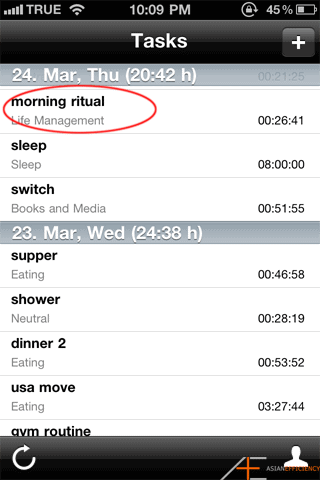
2. When I start eating breakfast, I switch to that.
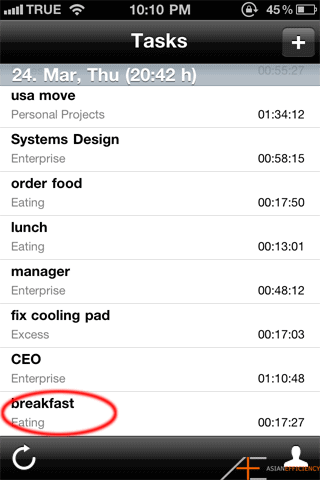
3. And when I start doing work for the day, I switch to that.
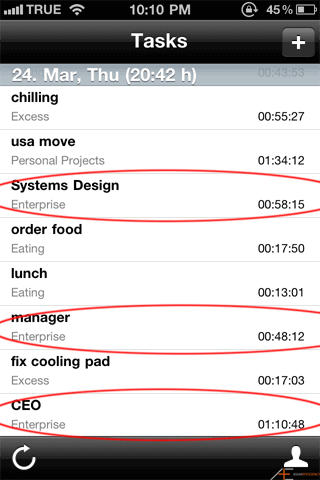
4. And this continues on for the rest of the day. Every activity gets its own item in Toggl (or Excel). Now if I have an activity that happens multiple times a day, for example my “daily actions” item, I’ll start the timer, stop it when I stop working on those daily actions, and when I come back to it, I’ll just restart the same timer. Technically I could create a new activity, but there’s no real reason to unless you want to measure data by time-of-day. In Excel, you have no choice but to create a new line item.
Something to note with Toggl (at least the mobile app) is that it is dependent on an Internet connection to work properly. Now sometimes, there is a synchronization bug where your activity time is wiped out by what the server was tracking. You’ll notice this when you have say [47:03] logged on an activity, and after a refresh it becomes [00:00]. The way I get around this is to look at my current activity when remember the time logged as soon as I open the application. If the time is overridden by the server, I tap on the time and reselect the prior time.
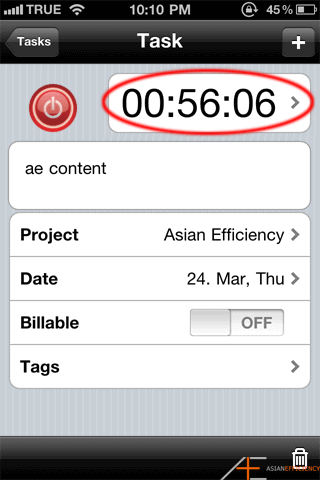
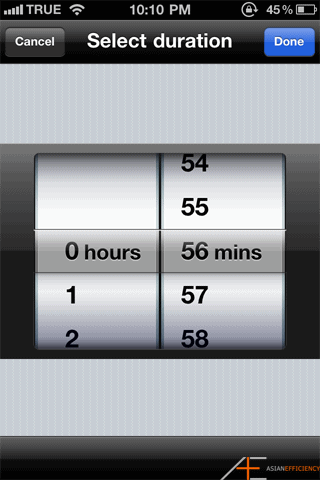
Unfortunately there is no long-term solution to this unless Toggl updates their mobile applications. If the Toggl guys are reading this – please fix it!
Elements of Time
So now that you know how to measure and track your time, we should discuss WHAT to measure.
This is highly personal. It will largely depend on how you structure your personal projects, your work, your task manager and your life in general. Below is a standard and simplified template based on my own systems that you can take and expand on.
I have the following projects setup in Toggl:
- Books / Media / Learning.
- Eating.
- Business.
- Excess.
- Life Management.
- Neutral.
- Personal Projects.
- Sleep.
- Social.
Let me explain each in detail, and answer some common questions as to “where does XYZ fit”.
Books, Media and Learning
This is any time spent reading, taking notes, watching educational videos or in general, absorbing information of any sort.
Eating
Breakfast, lunch, dinner, dessert, supper, afternoon tea, snacks, coffee breaks, etc etc
If you are a smoker I would put cigarette breaks in here or under “Excess” if you want the extra motivation to quit.
Business
I personally call this Enterprise. It is time spent in the office or working on office projects. I have very distinct individual items based on mental contexts for this, but if you work a 9-5 you can lump it all together under “work”.
Excess
Any time that is not productive (remember, we define productivity as time spent directed towards your goals). For me, this includes video games, chilling with my roommates, and doing things that I shouldn’t have to do (unexpected things that crop up and have to be taken care of). If you commute to work, I would consider putting commute time under this too, as a motivating force to find a more effective way to get to work, or to negotiate a remote working arrangement.
Life Management
I only allow four items in here: my morning ritual, my evening ritual, my daily actions and my weekly / monthly / quarterly / annual reviews.
Neutral
Things you have to do every day that are not inherently productive but more along the lines of essential. For example, taking a shower or doing your laundry (though I could argue that one under “Excess” too).
Personal Projects
Any time spent towards my personal projects. This can range from planning a vacation to handling financial affairs.
Sleep
Self explanatory: Sleep and naps. When you nap, start the timer. Stop it when you wake up. Same goes for sleep. Once you have enough data, you can optimize your sleep.
Social
Any time purposely set aside for spending with family or friends falls into this category. Not “unplanned” time (which should fall under “Excess”), but purposefully-assigned blocks of time for socializing with other human beings. Examples: dinner with friends, dates, time with the kids.
What About That Time I…
So sometimes an activity will have more than one productive purpose. For example, having dinner with friends could fall under “Eating” or “Social” in the setup above. As to which you assign the activity is largely up to you and what you want to track. Personally, I want to optimize the amount of time I spend eating, so if I’m eating alone it falls under “eating”. If I’m out with friends and catching up and socializing, it falls under “social”.
There are also other activities that will encompass a range of other activities. For example, when you go on vacation or when you’re spending time with friends. The two options here are to either 1) change item every time an activity switches, which can be annoying, or 2) create a large activity item that encompasses the smaller activities. On a night out with friends we may: 1) get drinks, 2) go to a lounge, 3) spend time in a taxi, 4) spend time at a fine drinking establishment, 5) eat food on the way home. I tend to classify this as just “going out” and file it under Social. As you’ll see when we discuss how to use the collected metrics to optimize your time, the actual individual line items don’t matter as much.
On occasion you will come across “necessary evils” in life. Visiting a doctor, helping a family member out in an emergency, needing to deal with your taxes etc… How you classify these is really dependent on what you want to do with these activities. My rule is this: if it is an activity that has arisen out of someone else doing something (i.e., I didn’t create the circumstances intentionally), I will file it under Excess. Why? Because then I become motivated to find a permanent solution to the problem, and to make sure it never occurs again. Now if it is something that you have to do (e.g., file taxes) I would actually consider that a Personal Project and log it accordingly.
Got any other questions about how to classify an activity? Post them in the comments below and we’ll answer them.
Review Time
You want to review your time data on a weekly basis. Daily is too much, and monthly is too long to chart any meaningful comparisons.
Here’s how you do it:
1. Export your data out of Toggl. Select Weekly Report. Select “Last Week”. And most importantly, click on “show” to refresh your data.
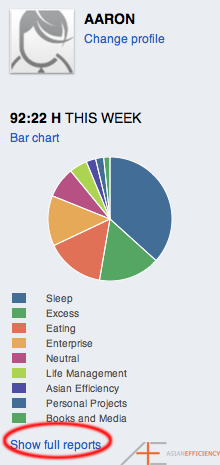

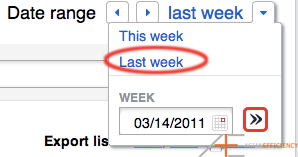

2. Export to CSV, and put it into an Excel spreadsheet, expressed in minutes for analysis.


Now you want to look at your data and ask yourself: should the time I spent on this activity or activity group go up or down for next week?
As an example, here’s some of my more recent data:

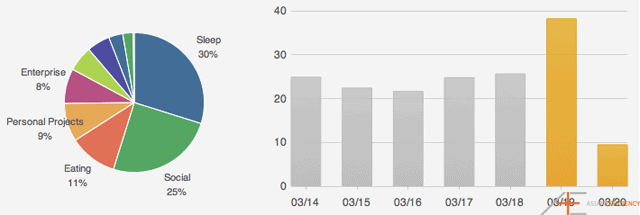
From the above, you can see that I’m working on increasing my focused working hours (“Enterprise”) and on decreasing the amount of time I spend eating.
Over time, you can chart what your life looks like in terms of time allocation. If you couple this idea with what your goals are (and what goals you’re achieving), you can actually work out exactly how productive you are really being.
Some average weekly numbers:
- Sleep – 3234 minutes.
- Work – 2610 minutes.
- TV – 1680 minutes.
* Source: US Department of Labor: https://www.bls.gov/tus/charts/
* Source: Sanchez-Tabernero, Alfonso (1993). Media Concentration in Europe: Commercial Enterprise and the Public. London: John Libbey & Co.
The interesting thing about collecting time data about your life is the ability to mash it up with other data you have available. A couple of thought-provoking examples are:
- Consider that the average worker has a 40-hour work week. What activities and what categories in your life exceed that 40 hours a week?
- If you’re into actively managing your finances, you will know what your Real Hourly Wage is. Using this, you can see what the opportunity cost of your “Excess” and other activities really is.
“This is your life and it’s ending one minute at a time.” – Tyler Durden, Fight Club
Next Actions
- Sign up for a free account at Toggl.com and install the application on your phone.
- Setup your categories of elements of time.
- Start tracking your time.
- Review weekly, and make adjustments for the upcoming week.
If you want to check out other time tracking options, there are exclusive discounts for time tracking apps inside The Dojo, our exclusive members-only community that is jam-packed with trainings, courses, masterclasses, podcasts, coaching calls, action plans, and productivity-focused individuals just like you.

Aw, this was an exceptionally good post. Spending some time and actual effort to produce a really good article… but what can I say… I procrastinate a
whole lot and never manage to get anything done.
I have to thank you for the efforts you’ve put in writing this website.
I’m hoping to check out the same high-grade content
from you in the future as well. In fact, your creative writing abilities has inspired me to
get my own, personal site now ;)
Well written.
I’m using one such employee time tracking software named, Desklog. It is an automated employee monitoring software which tracks the real time productivity of my team.
The advanced screen monitoring, app tracking, url tracking features makes it more effective and worth using.
I would strongly recommend using an employee monitoring software to keep track of the productivity of your team.
Know how does employee time tracking software work: https://desklog.io/blog/how-does-employee-time-tracking-software-work/
Great article! I am just looking for some suitable variant for my team
The post that you have shared is quite informative. I personally use a time tracking app to stay organized and productive at my workplace. if you are looking for any tool to manage your time better, try staff time tracking software. Super easy to use and really cost-effective as well.
Hi Serena,
Thank you very much for the recommendation) I’ve started using WebWork due to your recommendation. It a cool free tool. Thanks once more.
This is very good article to read! Very helpful, thank you.
I also use WebWork time tracker, which very helms me to manage time and be productive. It is very good tool, I recommend. The link to it is – https://www.webwork-tracker.com/
Anyone using it too? What about prices of the other softwares?
I’ve been tracking time now for almost a year, but it’s using a tool I built myself. I started it out of tracking time for work, but eventually I made the leap to track the time outside as well. Most of the tools I’ve found are for tracking work time, but I think that’s silly. Most of the time you can’t change what you’re doing at work. You couldn’t shorten or eliminate the time, unless you plan on quitting. The vast majority of my time that I can improve or change is personal time, and the options are much better because I could go anywhere or do anything.
My key has always been to focus on the outcome. What is it that I gained from that minute? Did it go towards a tool that can save me future time? Was it spent to eat? Was I asleep? Was I relaxing outside? Or was I wasting it watching funny videos? It’s good to have some downtime but you really have no idea how much time you spend until you can see it.
I do a review every 10 days of my time, and what I’ve been able to find fairly consistently is that I can go through the time items and pull out vast gobs of time. I don’t worry about the sleep – which is almost always the biggest item (and now it’s by far the biggest), because we as people need sleep. It’s not an option to not sleep. If you don’t sleep, you get sick or make stupid mistakes that cost even more time. Instead I focus on the biggest other items that I have control over.
I could have done that faster, or why did I spend so much time doing something, or that was a complete waste. Then I think of a specific concrete step that I can take, and how much time it will save. I focus on 3 defined goals for the next 10 days, which usually add up to 5-15% of the waking time. Proceeding like that, in 7 sessions I can double the amount I’ve gotten done. Of course, I’m not always perfect and sometimes will get back into bad habits or old failures from weeks ago, but overall I find I have a lot more time now.
I don’t see any tool online that is anything close to what I do, where I input the time and what I was last doing. Nothing to show a visual breakdown of the day. Most (like 80%) are focused on businesses, and the ones that remain are just simple stop/start timers, nothing is really 24 hour tracking or would have enough categories to represent the complexity of the number of tasks I’m engaged in. There’s nothing to support multitasking (which I admit I’m still working on. I presently just put a separate entry half way through which cuts the time in half for each item). No colour coding of what was time well spent, time on a task but could have been faster, time of questionable benefit, or time of absolutely certain uselessness.
What I want to know is, is there a market out there for this? Would people want a tool like the one I have? It’s a lot of effort to build a login system and harden the code and all that. I don’t want to waste my time, if at the end of the day I’d be the only one using it. So, is there anyone out there who would use it? Anyone reading this where that sounds like something you would end up using?
Ok, made an error in my last post. as I though the latest post was at the top of the page. So the last comment was far more recent on April 13, 2016, lol. :-)
So the last comment on this was April 10, 2012. Is there an update to this methodology. I am looking for a solid time tracking app that can work seamlessly between my Mac and iphone as well as export to programs such as Excel. Has anyone come across such software?
Thanks,
Ian
Did anyone ask about multi-tasking?
(i.e. eating while doing taxes; showering while listening to an informative audible; responding to emails while on a mandatory but useless- muted-work related-paid conference call <– lol relatable)
Can you click two activities at once?
Thanks so much for all your helpful articles!
Wow..thanks but I am use this app already if you have some new software or application for Android phone. Then please share by your post. But As you did recommended us about type of new feature that was awesome.
Hey, Is there anything like the “Hourly Diary” for Mac ? Thanks!
Time-tracking software is a category of computer software that allows its users to record time spent on tasks. This software is used by employees and employers.Very useful tips…Thanks for sharing.
A really great alternative to Toggl is Yaware.TimeTracker. Most of all I love that this app is working fully automatically, and you do not need to push start and stop all the time. https://timetracker.yaware.com/time-tracking-software/
Oh, time! I wish we all had more time. But, have to make the one you got work.
Time tracking software os great because it tells you a lot more than you would learn if you tracked your time by writing it down in a notebook.
My team only uses automatic time tracking software because it doesn’t distract them from work and I get accurate valuable insights about the performance of my team.
We use Yaware.TimeTracker to measure our productivity and record time spent working.
great experience. I have been always struggling with billing clients for my freelance jobs correctly and now I can do it easily,thanks.
JJ,
I got the same problem with the “stopwatch” and came up with the simple “total time” scheme what you track what you “have done”, not what you “have started to do”. It turns out much easier.
The app is TDouble (tdouble.weebly.com) – free for Android.
Pavel
Great post!
I myself got interested in the topic recently and started to use Excel for tracking by activities. I still beleive that Excel is the best tool if you are to organize you work day ))
However, if your life is more dynamics than sitting at the desktop and just work, mobile app is the best tool to get your activities in one place.
I see basically, two wide approaches for the applications. First is “stopwatch” scheme, which is followed by numerous apps like Time Meter, Toggl, aTimeLogger, etc.
The second is “total time” approach where you do not have to press start and stop buttons to fix time of the activitiy. The time runs on its own and, thus, you will not miss a minute.
Actually, I have came up with TDouble (tdouble.weebly.com) for Android, and start using that as it is more comfortable to me personally. Quite simple and efficient.
If you are looking for an alternative for Toggl, I would suggest to try Yaware.TimeTracker. It is simple yet very powerful time tracking app, highly recommended.
Just tracking time is an interesting exercise as well. It makes you really aware. Here is in an interesting post re productivity, brain science, and how to be more aware of your unproductive task switching habits during the day https://www.bigtime.net/track-your-productivity/
Aaron, you exactly did pen down the words I wanted to ask. We are trying to be religious about time tracking for our own benefits and there are innumberable reasons to consider a tool. The love for administration tasks has had my co-founder find an app that makes life easier, run the business smoothly. I’ve literally tried a dozen task management, time tracking, project management apps!
Thanks for the awesome post. I want to up my productivity and am looking for the best app to use. I have used Rescuetime before but it’s still a lot of manual setup. I’m wondering how Toggle compares to Rescuetime?
I’ve tried several approaches to time tracking but they often fall short because there’s no mechanism to catch myself if I forgot to record my time entry or forget to hit the start/stop button in the time recording app. For example, with the old-school spreadsheet approach, it actually takes more discipline than is obvious at first glance to be able to interrupt what you’re currently doing and fire up your spreadsheet at regular intervals to record what you did. And if you forget because you’re completely in the zone while working and try filling it out after several hours, you’ll be hard pressed to remember what you were actually doing earlier in the day.
The approach utilized by various apps with a “start” and “stop” recording button suffers from a similar setback. I’ll often forget to press start or stop and my time tracking ends up being irreversibly “messed up”. There’s no mechanism built into the app that allows me to remember to press “start” or “stop”.
So I propose a 3rd approach: the Time Tracking app will ping you at regular intervals and ask you to fill out what you’ve been doing (and rate your energy and time use on a scale of 1 to 5.) So you don’t have to rely on your busy brain to remember to fill out your time spreadsheets when you’re in the zone working on important projects then have to remember details of your time use at the end of the day. I’m no programmer by trade but I’ve built a simple prototype Android app that utilizes this approach. Just search the Google Play store for “Hourly Diary”.
I’d just like to get this idea out if any developers who are considering building a time tracking app are reading this post.
I also use http://www.timecamp.com – great experience. I ‘ve been always struggling with billing clients for my freelance jobs correctly and now I can do it easily.
I’ve heard great things about Toggl from friends and colleagues and I’ve been meaning to give it a try for a while. Thanks for all the info, Aaron!
Another one to the list is Mobile Worker (https://www.mworker.com) time tracker. It’s a very simple-to-use one-click time tracker with document sync & invoicing options. Unfortunately, it’s only available for Android devices. But if you need something light and simple, it’s an option that should be considered.
I like this post very much! All that is said here is true. My team work on TimeCamp and we are satisfied because we all know each other’s work involvement. It’s ever so motivating.
Hello…?
Any ideas / suggestions at all…?
I’d even settle for something like a Vitamin R and Toggl integrations, though it’s not my favorite time tracking app – but it does have a desktop and iPhone interface, and does have Projects and Tags (which can work like tasks).
Any ideas???
Quick question… Anyone know if there’s a way to integrate something like Vitamin R with Tyme? I dig Vitamin 6’s Pomodoro task management, task motivation and anti-distraction features. But it kinda sucks as far as time tracking goes, apart from tracking one’s focus. On the other hand, apps like Tyme have a really neat looking layout as far as tracking projects and the tasks within them (which sometimes overlap with other projects), and the graphic reports look much nicer on Tyme. Any way these two apps can get married and work together? Or is there another app out there that has both of these features combined? I’ll take my questions off the air.
Terrific post! It’s been a while since this article went up, and so I’m wondering if there’s any updated info about preferred time tracking apps?? I saw that the author originally suggested Toggl – and then switched to aTimeLogger. I mostly work on my laptop, and so the Toggl desktop app — and syncing interface with my iPhone (and iPad) — is appealing. But I’ve checked out the aTimeLogger app (now there’s version 2), and that also looks great. Ideally, I’d like to use something like that app, but with a desktop syncing interface (if possible), and have the ability to produce detailed, weekly reports — breaking down the amount of time I’ve spent, per task. (I don’t really care if they’re produced via PDF, CSV, Exel, etc., just as long as they break down clearly — preferably in a pice chart and bar graph.) Oh, it would also be great if there a way to work on some time tracking app while using Pomodoro… Yes, I know they’re different functions, but it wold eliminate the hassle if it were just a more seamless function to run both at the same time.
What do people suggest these days? Based on what I’ve describe, are there particular time tracking apps that seem better? I’d appreciate any ideas / feedback you can provide on this topic… Thanks!
I had the very same question. anyone have insight or suggestions? i’d like to use a time tracking app in the very same way: a desktop version for my laptop that can sync w/ an iphone app (if possible), and produce good reports on the amount of time expended on TASKS. thought toggl was the way to go, but not people rave about atimelogger. what’s the verdict?
You can try Yaware (https://yaware.com/). It is mostly used for employee time tracking, but I use it personally. It runs in the background on the computer and tracks the amount of time I have spent on apps or websites. It also evaluates my productivity. When I visit Facebook or something like that it shows an unproductive time in % of the daily productivity. I can check my statistics online and receive daily or weekly reports. So it is easy to analyze what takes my time.
Hope I have helped you)))
Do you have re-enter evening ritual every single time, or can you use it repeatedly?
You can use it repeatedly!
Specifically for developers, there are some interesting activity tracking apps, which record the work done inside the IDE:
– Codealike for Visual Studio & Eclipse (www.codealike.com/)
– Codeivate for sublime (www.codeivate.com/)
– Mylyn for Eclipse (www.eclipse.org/mylyn/)
And few others.
Unlike toggl, these apps don’t require of manual data entry, and unlike RescueTime they keep track specific coding activities, with a higher level of granularity.
The idea of this kind
I have read this post many times as well as the other articles, so informative, I have been adapting my approaches based of the results from time fragging and keeping a journal, I do wonder 2 things.
1- pomodorro is a pomoddoro 25 min + break or 25 min. I have 2 timers right now, time tracker in the form of atimelogger and chronology for pomodorro’s. But do I track a pomodorro as 25 min and then a break or just leave the thing running until 4 pomodorro’s are over (as long as I don’t get distraction, I stop the pomodorrow If i have my attention elsewhere).
2- when you gonna do that update you promised us haha.
thanks
Are you guys still using toggl?
Looks like they’ve switched to aTimeLogger.
I think it’s a good switch. I tried Toggl for a couple days and found their iPhone app less than stellar. aTimeLogger is a much easier app to use even if it doesn’t have a web option like Toggl.
First, time on this site… Well played, well played. Don’t know if I’ll ever get a task list or chart to look exactly how I envision it. Trying to increase efficiency inevitably leads to inefficiency. Usually I get worn out and overwhelmed and frustrated. Mapping out a giant spider graph of post it’s in varying sizes and shades of neon on my kitchen wall. My attempts end in annoyance. Stay Awesome Asian Efficiency :)
Ya. Toggl is my choice for desktop, its great and simple, but doesn’t allow me to edit my time. I’ve found recently for Android. It has similar behaviour, so it’s my choice when I’m outside my office, or not using my computer. Phone is always with me :)
Exactly how much time do you spend on time tracking? (Minutes per day? Hours per week with the spreadsheets and graphs?) I find myself spending countless hours organizing…Wondering if there is a more efficient way!
I tried toggle and it kept screwing up my times. One day had 104 hours in it! Some of this was my fault for having to go back and add times and messing up the am and pm but it would NOT let me fix it!
What’s the story behind the photo at the top of this article? Just curious.
This article is of immense help to me. Every detail is captured in it. Thank you!
An alternative to toggl is rescue time. Multiple computers, single report, broken down pretty well.
Great post, thanks so much for the indepth help. I am definitely going to give this tool a try. I’ve been experimenting over the last 2 weeks with some rudimentary time tracking and have been really impressed with the insights I can discover! I detailed my thoughts here: https://barrymorisse.com/time-tracking-1/
Anyway, keep up the great work!
Nowadays, having an employee monitoring software is very important. May it be for personal use or for business use to monitor our staff. It is our responsibility to monitor our staff’s productivity. We should keep a variety of records, including the staff’s time. That’s why our company is using “TimeCase” (https://www.timecase.net) It helps us a lot.
Wish there were some way to do this without having a smartphone…
Great article Thanh. Its good to see that there are lot of options in terms of time tracking software. I am a freelancer as well and we are using Time Doctor to track our hours worked. It doesn’t just track our time but the software lets us monitor our remote workers as well by providing us reports on what basically are they working on. This various software has saved us time and money in making sure that we are productive and efficient while working.
I’ve never heard of Time Doctor but it seems like something I would use. Good to hear you’ve had a lot of success with it.
Wow! I just read over this and really appreciate the detail you went into…so helpful! I am a stay at home mom and want to see how I am really using my time and lessen some spent on “time wasters.” I’m considering going back to work but from home and wanted to see if the time really is there and keep myself accountable as well. Your article is just the thing to get me started. I’m looking forward to reading more of your blog as I have the time and will be passing it along to my korean hubby. He will love not only the content (I think) but also the cool name of your blog and of course the fact that you ended this post with a Fight Club quote. :)
Haha thanks! Glad our stuff is useful.
Great article!
Classifying actions was somewhat discussed, but it can also be used effectively to become more productive. I feel like tracking the most productive action you are doing at a certain moment gives you an incentive to become more productive. For instance I put commuting under excess if that’s the only thing I’m doing. Not because I can lessen commuting time, but because I can do more important things while commuting, like working, studying or reading. Should I do any of that, I log the time as doing any of those more important tasks.
That’s a great idea Simon. I like it. I didn’t pay attention to that but I can see how if you log certain activities that you’ll be more likely to push through, e.g. logging a task as “work” will more likely push you to finish it.
Hi,
Off the back of my Evernote2Omnifocus script. I have knocked together Omnifocus2toggl, a simple applescript that starts a new toggl task named after the selected Omnifocus task.
https://dl.dropbox.com/u/7879026/omnifocus2toggl.scpt
I tried using the Toggl API, and although I could import the task I could not ‘start’ an event.
Hope this helps somebody.
Nick
Are you still using Toggl? Have you tried going back to it? I really prefer having the reports and the online storage of the data, but since I also use Toggl to track billable time I really don’t like seeing glitches with the synchronization and possibly loosing entries.
I’ve just downloaded aTimeLogger and it definitely seems well suited to the approach/objective outlined in this post, but definitely less useful to tracking billable time (i.e. clients, projects, tasks, etc)
I’ve had problems in teh past sometimes forgetting to track time for several days in a row, so I think the idea of constant tracking could work well for me. I’m going to try it for the next week or two, though I will probably have duplicate trackers running at some points which can’t hurt I guess.
I can also recommend checking out VitaminR. It is not perfect, but I think its a pretty good and probably on the right track. A cheaper alternative I like is https://github.com/ugol/pomodoro or get the binary for cheap on the app store.
Hey Ryan,
This article is much in need of an update – it’s coming soon, I promise!
Thanh introduced me to aTimeLogger and I love it – easy to use, and very straightforward.
As for pomodoros, I’m looking for a new timer. Just reinstalled Lion and it seems the App Store app no longer exists :(
I just saw a pomodoro app for ipad that is free right now (on AppsGoneFree). The app is called Pomodoro Plus HD I don’t have an IPad so, I can’t say how good it is but, I thought I would pass it along. Did you ever make an updated article on aTimeLogger? I installed it but, am having some trouble figuring it out. I will try again but, wondered if there was a good source for how-to. Thanks
Do you guys have any idea about how to integrate Pomodoro with time tracking. I have not found a perfect solution yet. Hopefully you guys have some suggestions to share.
Hi Bruce you can consider as two different tracks. For example, you can track your time on your smart phone and your pomodoros on your desktop. Or just two different time trackers.
It’s not perfect and integrated but it does work.
Currently, I found the same way as you said. It works, however, not perfect.
Wonder if you guys have any experience with using Vitamin R, the Mac Store App that relies on Pomodoro strategies and also integrates with Omnifocus. It’s got some really cool features.
Hey Ty I haven’t used Vitamin-R. I didn’t know it integrates with Omnifocus. That sounds very interesting and I will definitely take a look at it.
I made some modifications that have been helpful in getting my time in order.
I added a “No-Nos” category (or you can call it “destructive behaviors” or something if you don’t like innuendo….). Most people will be able to put in things like screwing around on Facebook and procrastinating in here, and anything else will vary from person to person—smoking, thinking destructive/depressing thoughts, stalking your ex, fighting with your sibling, whatever. Then you can see at the end of the week how long you spend doing things you really SHOULD NOT be doing. Say you spent 2 hours last week beating yourself up for being overweight and an hour smoking. You will see that destructive activities stole 3 hours of your time. Those 2 hours criticizing yourself could have been better spent working out (or meditating to stop the thoughts), and the hour on smoking could have been spent on doing something to get your mind of nicotine AND that adds to your productivity/life organization (such as meditating, organizing your finances, or calling your mom). The goal is to eventually see this category’s time allotment shrink as your productive categories’ allotments rise.
(note: It’s helpful to know that Toggl will group items that are named the same and are under the same Project. So each time I screw around in Facebook I call it “Facebook,” each time I think negative thoughts I put “Negative thoughts,” so I can see the kinds of No-nos I do. Stuff like facebook will probably be inevitable, but I can lower when I think negative thoughts and see “Personal Betterment” rise.)
Next, I do not have an “Excess” category. I think making time for general rest and relaxation is just as productive as working on a project or business, so I have an “R&R” category (as well as a “Relationships” category to put in when I am spending time getting to know my friends, family, and partner better). This division makes it easy to see when I am procrastinating, and when I am actually relaxing. I have to be truthful to myself when I’m categorizing “watching Hulu”—am I doing it to relax after a good-day’s work, or am I putting something off? If the latter, it goes into “No-nos” and I will be able to see at the end of the week where I can better use my time (also, the very idea of putting this into the No-no category can make you stop and think before you go through with it!); if the former, then it goes into “Rest and Relaxation” and I can feel good about winding down with some 30 Rock.
Hi, thank you for all the well written tips about productivity.
I have been interested in this kind of time tracking for a while, this application seems good, what would be nice is if there was some way to sync the data with the calendar by creating events for the time spent on the various activities. Do you maybe know of a application or service that does that kind of thing?
Thank you
Thank you for the articles and the tips, I’m giving Toggl a try. I’ve been wondering how I can make sure I spend a certain hours per week on certain projects, and I’m not sure how to do that on Toggl, or if it’s possible at all. These are all long term projects (like REAL long), different stuff I need to do for my PhD, and I tend to spend much longer on the ones I like best. I wanted to make sure I’d spend 15h/week on each of them. Ideally, I’d like some kind of counter starting with said 15h for each project that I could keep going while I’m working on it. Then, if I do all 15h of something (of course not straight hours, but spread out in various times and days), I’d force myself to move on to the next thing until the following week. I guess I could keep checking how many hours I’ve already worked with Toggl, but I’m afraid I might go overtime if I don’t check often enough. Any ideas?
Hi Maria,
That is not possible in Toggl but there is a simple fix for this: review on a regular basis. I would suggest to do a review each week where you look at the time spent on your various projects. If you see that you didn’t spend enough time on project X, then you know you have to make an extra effort the following week on this particular project. Since this is for your long-term projects, a weekly review with adjustments should work just fine for you.
I really enjoy all the articles from Asian Efficiency!
Aaron and Thanh – I would appreciate it if you could check out our time tracking App. It is a mobile time clock with interactive GPS Mapping, paperless timesheets, payroll reporting – it’s a time tracking solution for any company with a remote workforce.
You can also use it for personal time tracking – we have a job order costing feature so you can assign projects and keep track of the hours spent on those projects. And as an answer to Quora – Labor Sync has both notes and messaging features.
Check it out and let me know what you think.
I’m so glad that I stumbled onto your website. Fantastic posts. Your insights are brilliant, and I especially appreciate the step-by-step directions. I downloaded Toggl on my iPhone and am checking it out. I look forward to more of your posts.
Thanks for the kind words Kimberly! We also suggest checking out aTimeLogger for time tracking: https://itunes.apple.com/us/app/atimelogger/id358979305?mt=8
Have another question/clarification – your advice is to use Toggl (or whatever) to track your activities. Aside from that, you also suggest Promodoro for work. Isn’t that taking too much of your time already? Clicking your mobile timer to track your activities and then you’re at Promodoro to track your tasks?
In reality it really doesn’t. The pomodoro timer is more for me to remind myself to stop and take a break. Not necessarily for tracking the time I’m working.
Using the Pomodoro technique: 25 minutes of highly concentrated work and a 5-minute break together are worth at least 30 minutes of normal work!
So you can use the Pomodoro timer and in the meanwhile you just let toggl run (don’t stop it during the 5-minute break!).
Great post! I just so love your site! I want to be productive big time and your tips especially coming from an Asian is a welcome treat, really! Would just like to share another iPhone-based free app that can be used in place of Toggl. I am trying to use aTimeLogger. Instead of Projects, what they have are Activities. They have built-in Categories/Activities with pre-defined icons which you could play with. My icon for Excess is a skull! LOL! You could also export your weekly, monthly, annual reports via email as a CSV file or HTML. No web-app, though, nor Desktop.
Keep up the good work, guys! I love your site, tutorials (esp. Omnifocus!).
Blessings,
Sarie
Hey Sarie,
Thank you for your kind words! I’ve been using aTimeLogger for months now and I have to say, it’s a really good app. My icon for “Excess” is a skull too haha. Every time I press that it just reminds me to keep that excess as short as possible. Also, with the export feature, I send it out to my VA and he puts them into Excel for more analysis. I can highly recommend doing that.
My is skull too, I just start using aTimeLogger
Good post, it is very informative. I
am also using a time tracking software to track how productive I am. This
software helps me organize my daily activity priorities with less effort and
more work has been done. This software is called RescueTime and it has
different features that can also help you stay focus on your work. It can
blocking website for a period of time. This article also discusses comparative
reports on time tracking software.
https://www.timedoctor.com/blog/2010/07/25/how-is-time-doctor-different-than-rescue-time
Covers me on Android, definitively gonna try it out!
Hmm Toggl is interesting I am testing it out. With the pomodoro technique though there would be 5 minute breaks included in the time it takes to complete a project. I guess due to consistency the data Toggl can provide are still useful.
After using Toggl for a few hours I realized how simple it is to implement Pomodoro break and time tracking. Basically the website is so user friendly stopping your work and adding a break timer is a matter of less than 20 seconds. I just work on the project I am working on, press Stop, type Break, start….stop then back to the project.
Yes exactly. Doing that will give you an accurate idea how long you’re really working and what your days look like. It’s pretty eye opening and interesting the more data you track.
Aaron,
I love this post!
I need to register to Toggl and see how it works.
Seems that this would be a ideal tool if I had an iPhone and I’ll download the client when I have one :) (or, perhaps this is the reason to have one :)
Just wondering if this tool would be working in the client situations too (if they have an iPhone …)
Timo
I’m not quite sure what you mean by working with client situations – I had personal time tracking in mind when I wrote the article.
Toggl was originally designed as a time tracking tool for freelancers to accurately bill hours and such, so it should be adaptable to business scenarios.
ps iPhones are awesome. Highly recommend getting one.
Aaron,
Ok, I got it now :) I figured that this would be cool way to track your customer’s time as well, but it is geared more towards your personal time tracking.
Anyway, I’ll have to take a look at it further.
Cheers,
Timo
After 4 days with toggl, I’ve got to say I’m satisfied!
At first, I thought I worked in too many places at once to be able to track my time manually, but it has really worked. Also, it forces you into singletasking, which is great.
Have you found any other tools for time tracking like this? I’m looking for the best possible solution here…
On OS X, of course.
Yeah time tracking this way really forces you to single task, but it also makes you more aware how you are spending your time. If I look at my phone and I see that an hour has gone by of “Excess” time, it really makes me think twice what I should be doing.
Recently I switched to aTimelogger on my iPhone. It’s similar to Toggl app, but I find it a little nicer to use. However, it doesn’t have the data stored online (like Toggl) so you have to manually calculate everything in Excel. But I have my virtual assistant do all that for me. Every week I send my data and he puts everything in the excel sheet. All I have to do is review it every week, analyze how I can improve, and then make the adjustments.
I would say, keep tracking more data. Four days is not enough yet to make adjustments. Try to review it every week After two months of data, you can really start seeing how you spend your time. That’s when you can see how many hours a day you actually work, how much sleep you need, etc.
If you want some extra time tracking, I also use Rescuetime (paid for full version). This tracks which websites and applications you use the most. I use it as something extra on top of my weekly review. I use my aTimelogger data primarily, but alongside I use Rescuetime data to see how I can improve. For example, if I see that facebook is my #1 website, it makes me think how I can decrease my “excess” time in aTimelogger. And so on.
I believe time tracking that much is not necessary. At least not for me. And I doubt it would be for others as well.
It simply wouldn’t make me more productive. Actually, it would make me kinda crazy. And, in the longterm, that’s very unproductive.
I’m a student. I’m writing on a book. That’s my two projects. Now, I know I don’t have the same needs as a CEO or MC at McKinsey, but so far I have had great progress on having few projects. I’m a firm believer in it. Thus, I have two: Academic work and Writing work.
Right now, I’m saving everything I do on my computer automatically with RescueTime and Lapsus, and I’m manually saving my work on the book with Toggl. At the end of the day I can se how much time I’ve spent on the one project that matters — the book project.
In the future I may have a look at the RescueTime or Lapsus data and ask myself where my time goes. Analyzing of that sort can be eye-opening but, as for now, I’m too busy for that. I’ll do it later (Read: Someday/Maybe).
Yeah I agree that not everyone needs to track all their time 24/7. It’s good that you track time, because that allows you to see every week how much work you’re actually getting done. And numbers don’t lie.
I would continue having your setup and see on a monthly basis if your time spent on Academic and Writing work is consistent. If it’s slipping two months in a row, that might be a sign to refocus and start spending more time on your important projects.
I believe time tracking that much is not necessary. At least not for me. And I doubt it would be for others as well.
It simply wouldn’t make me more productive. Actually, it would make me kinda crazy. And, in the longterm, that’s very unproductive.
I’m a student. I’m writing on a book. That’s my two projects. Now, I know I don’t have the same needs as a CEO or MC at McKinsey, but so far I have had great progress on having few projects. I’m a firm believer in it. Thus, I have two: Academic work and Writing work.
Right now, I’m saving everything I do on my computer automatically with RescueTime and Lapsus, and I’m manually saving my work on the book with Toggl. At the end of the day I can se how much time I’ve spent on the one project that matters — the book project.
In the future I may have a look at the RescueTime or Lapsus data and ask myself where my time goes. Analyzing of that sort can be eye-opening but, as for now, I’m too busy for that. I’ll do it later (Read: Someday/Maybe).
You guys did a wonderful job covering the HOW and WHAT of Time Tracking, but not much on the real WHY. I mean, this will provide potentially useful data, for sure. But, in the bigger scheme of things, what real value does it provide? We can get so caught up in the minutia of time, task & project management that we forget the there is a whole forest out there just beyond the single tree that happens to be in front of us at the moment. If you could describe some real-life benefits you have experienced as a result of timme tracking, it would help us decide whether we should or should not incorporate it into our busy lifestyles.
Aaron & Thanh, keep up the GREAT work! Your site is jam-packed with wonderful tips to those of us who are sincerely trying to improve productivity in our lives.
Thanks Michael!
I actually did a short interview with the CEO of Toggl on what benefits came out of tracking my time.
I don’t really see time tracking as an inconvenience to how I go about my day – whenever I start a new activity I just start a new timer. As for the benefits, the big one is this: it really calls you on your own BS.
For example, most people who work from home (myself included) like to tell ourselves that we work more than the standard 40 hours a week. But it’s just simply not true. The reality is more that we work about 20 hours a week, with lots of errands and other things in-between. Those 20 hours may be more productive, or they may not be more productive. And without time tracking, there would be no concrete data to verify.
I’ll put down a follow-up article on the “why” of time tracking on our upcoming article schedule – probably somewhere close to December.
Hi Aaron,
It’s October 2012 (and I just stumbled upon your website a couple weeks ago). Great site!
But I’m wondering, can you link me to this article? Thanks!
-Sue
great piece. sounds like i should get an iphone!
I like this blog a lot.
Respect to the Asian Efficiency.
Just started tracking using toggl. Appreciate the stuff you guys are putting out. I have a serious problem with procrastination. Goof around a lot instead of working on my business. Putting into practice some of your tips
Thanks for the kind words. Time tracking is a great place to start so you can become aware of how you spend your time.